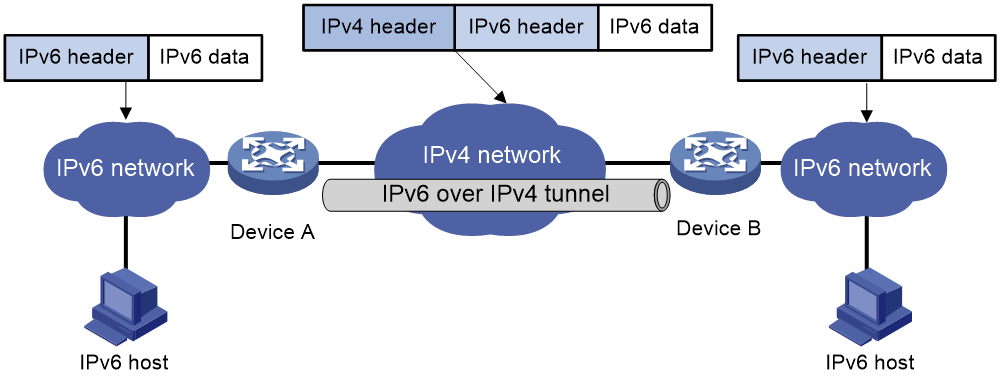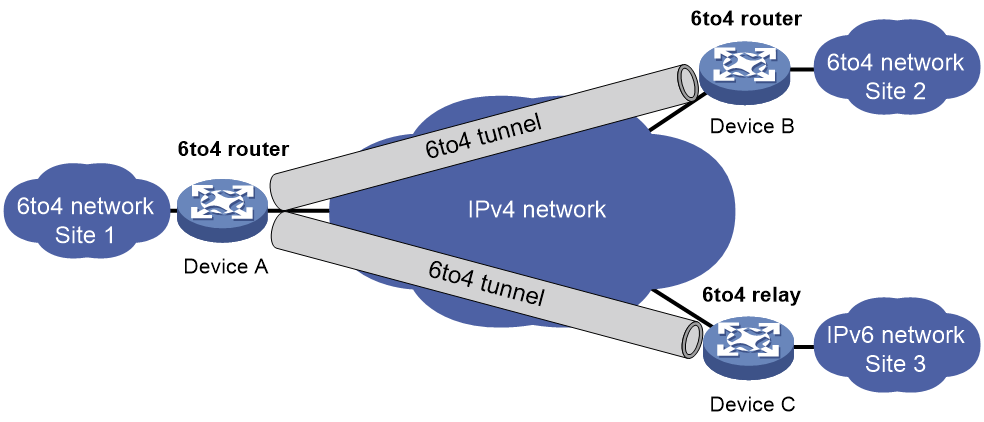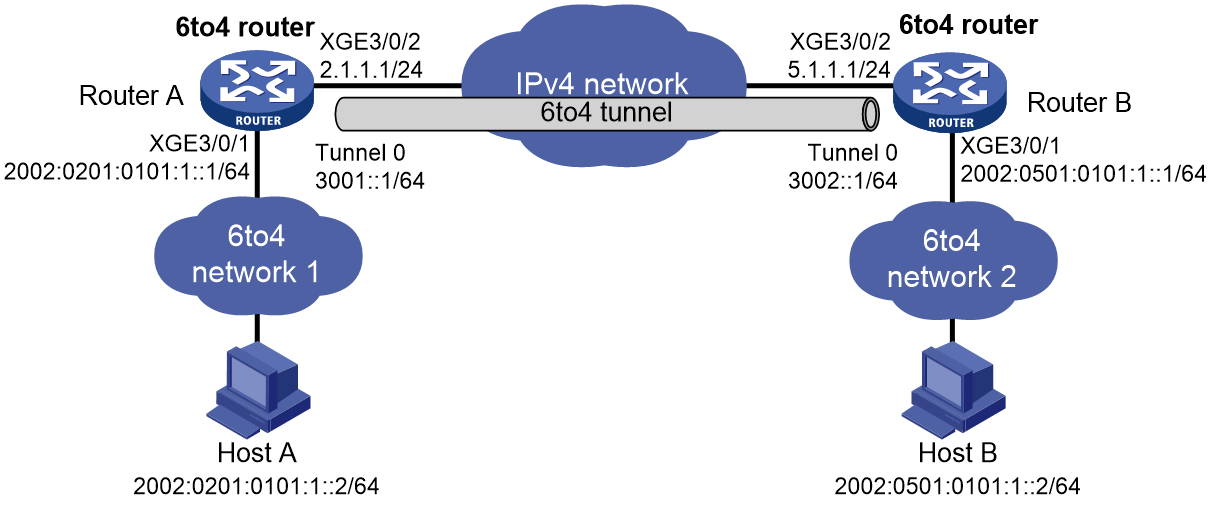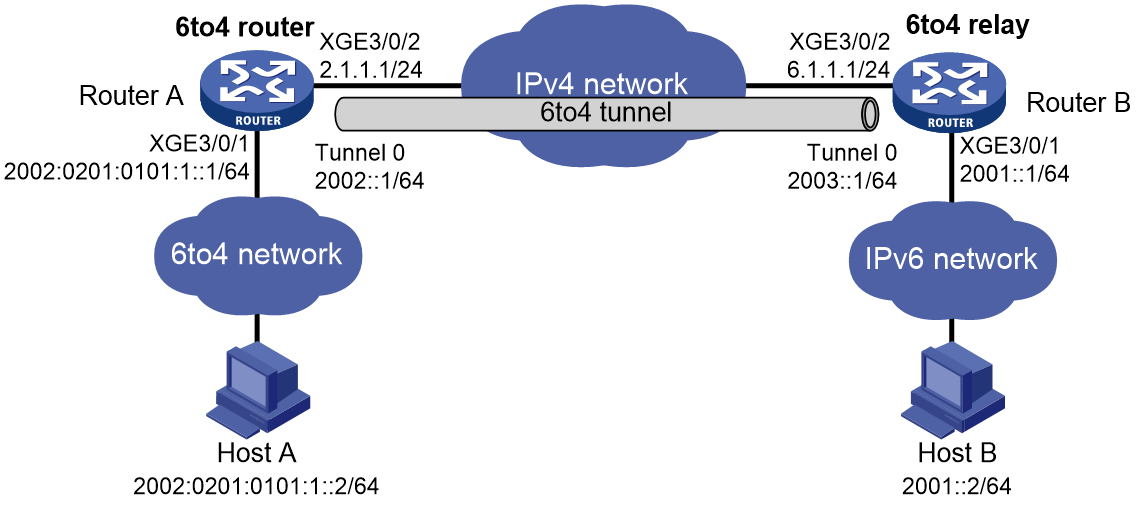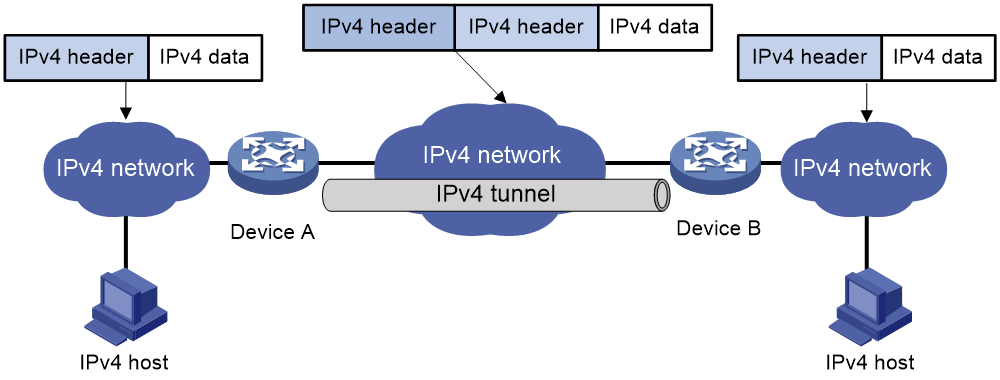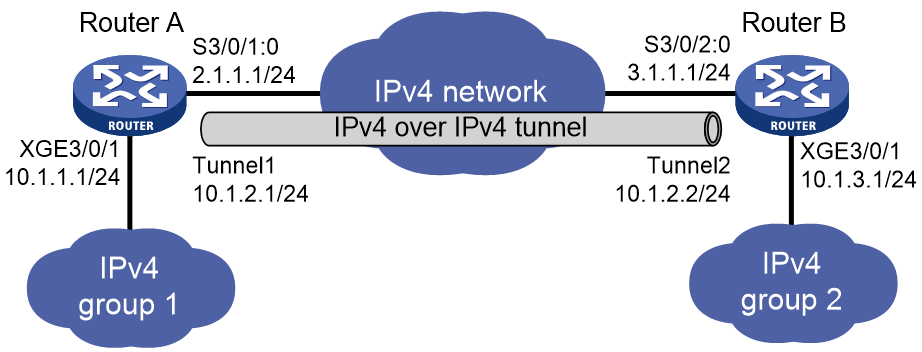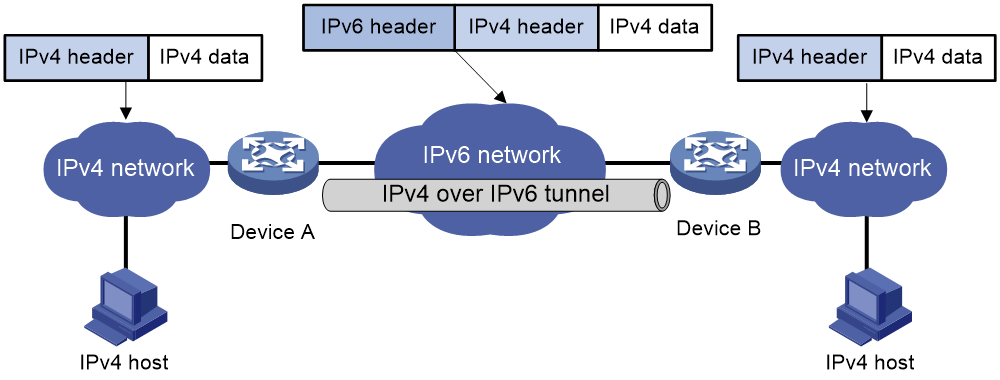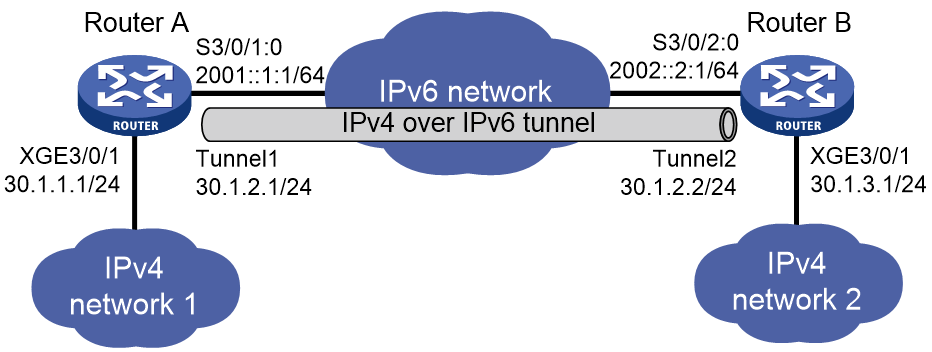- Table of Contents
-
- 05-Layer 3—IP Services Configuration Guide
- 00-Preface
- 01-ARP configuration
- 02-IP addressing configuration
- 03-DNS configuration
- 04-mDNS relay configuration
- 05-IP forwarding basics configuration
- 06-Fast forwarding configuration
- 07-Adjacency table configuration
- 08-IRDP configuration
- 09-IP performance optimization configuration
- 10-UDP helper configuration
- 11-IPv6 basics configuration
- 12-IPv6 fast forwarding configuration
- 13-AFT configuration
- 14-Tunneling configuration
- 15-GRE configuration
- 16-HTTP redirect configuration
- Related Documents
-
| Title | Size | Download |
|---|---|---|
| 14-Tunneling configuration | 375.91 KB |
Contents
Supported tunneling technologies
Restrictions and guidelines: Tunnel interface configuration
Configuring a tunnel interface
About tunnel interface configuration
Tunnel interface configuration tasks at a glance
Configuring parameters for tunneled packets
Specifying the tunnel destination VPN instance
Restoring the default settings of the tunnel interface
Specifying an output interface for tunneled packets
Setting the statistics collection mode for tunneled traffic
Display and maintenance commands for tunnel interface configuration
Troubleshooting tunnel interface configuration
About IPv6 over IPv4 tunneling
IPv6 over IPv4 tunneling tasks at a glance
Configuring an IPv6 over IPv4 manual tunnel
Example: Configuring an IPv6 over IPv4 manual tunnel
Example: Configuring a 6to4 tunnel
Example: Configuring 6to4 relay
Example: Configuring an ISATAP tunnel
Enabling dropping IPv6 packets that use IPv4-compatible IPv6 addresses
About IPv4 over IPv4 tunneling
Restrictions and guidelines: IPv4 over IPv4 tunnel configuration
Configuring an IPv4 over IPv4 tunnel
IPv4 over IPv4 tunnel configuration examples
Example: Configuring an IPv4 over IPv4 tunnel
About IPv4 over IPv6 tunneling
Configuring an IPv4 over IPv6 manual tunnel
About IPv4 over IPv6 manual tunneling
Hardware compatibility with IPv4 over IPv6 manual tunneling
Example: Configuring an IPv4 over IPv6 manual tunnel
Configuring tunneling
This chapter describes tunnel interface configuration. For information about tunnel modes, see the subsequent chapters.
About tunneling
Tunneling encapsulates the packets of a network protocol within the packets of a second network protocol and transfers them over a virtual point-to-point connection. The virtual connection is called a tunnel. Packets are encapsulated at the tunnel source and de-encapsulated at the tunnel destination.
Supported tunneling technologies
Tunneling supports the following technologies:
· GRE tunneling. For more information, see "Configuring GRE."
· MPLS TE tunneling. For more information, see MPLS Configuration Guide.
· IPsec tunneling. For more information, see Security Configuration Guide.
· VXLAN tunneling and VXLAN-DCI tunneling. For more information, see VXLAN Configuration Guide.
· IPv6 over IPv4 tunneling, IPv4 over IPv4 tunneling, and IPv4 over IPv6 tunneling.
Restrictions and guidelines: Tunnel interface configuration
When an active/standby switchover occurs or the standby MPU is removed, the tunnel interfaces configured on the active or standby MPU still exist. To delete a tunnel interface, use the undo interface tunnel command.
You do not need to use the ip address or ipv6 address command to configure an IPv4 or IPv6 address for an IPv4 VXLAN, IPv6 VXLAN, IPv4 VXLAN-DCI, or IPv6 VXLAN-DCI tunnel interface. The IP address is meaningless.
Configuring a tunnel interface
About tunnel interface configuration
Configure a tunnel interface (Layer 3 virtual interface) at both ends of a tunnel. The devices use the tunnel interface to identify, process, and send packets for the tunnel.
Tunnel interface configuration tasks at a glance
To configure a tunnel interface, perform the following tasks:
1. Creating a tunnel interface
2. (Optional.) Configuring parameters for tunneled packets
3. (Optional.) Specifying the tunnel destination VPN instance
4. (Optional.) Restoring the default settings of the tunnel interface
5. (Optional.) Specifying an output interface for tunneled packets
6. (Optional.) Setting the statistics collection mode for tunneled traffic
Creating a tunnel interface
Restrictions and guidelines
An IPsec tunnel and a GRE over IPsec tunnel cannot use the same source IP address, the same destination IP address, or both.
Procedure
1. Enter system view.
system-view
2. Create a tunnel interface, specify the tunnel mode, and enter tunnel interface view.
interface tunnel number mode { gre [ ipv6 ] | ipsec [ ipv6 ] | ipv4-ipv4 | ipv4-ipv6 | ipv6-ipv4 [ 6to4 | isatap ] | mpls-te | { vxlan | vxlan-dci } [ ipv6 ] }
For packet tunneling to succeed, the two ends of a tunnel must use the same tunnel mode.
3. Configure a source address or source interface for the tunnel interface.
source { ipv4-address | ipv6-address | interface-type interface-number }
By default, no source address or source interface is configured for the tunnel interface.
If you specify a source address, it is used as the source address of tunneled packets.
If you specify a source interface, the primary IP address of this interface is used as the source IP address of tunneled packets.
4. Configure a destination address for the tunnel interface.
destination { ipv4-address | ipv6-address | dhcp-alloc interface-type interface-number }
By default, no destination address is configured for the tunnel interface.
The tunnel destination address must be the IP address of the receiving interface on the tunnel peer. It is used as the destination IP address of tunneled packets.
5. (Optional.) Configure a description for the interface.
description text
By default, the description for a tunnel interface is Tunnel number Interface.
6. (Optional.) Set the MTU of the tunnel interface.
mtu size
The default settings are as follows:
¡ If the tunnel interface has never been up, the MTU is 1500 bytes.
¡ If the tunnel interface is up, its MTU is identical to the outgoing interface's MTU minus the length of the tunnel headers. The outgoing interface is automatically obtained through routing table lookup based on the tunnel destination address.
7. (Optional.) Set the expected bandwidth for the tunnel interface.
bandwidth bandwidth-value
The default expected bandwidth (in kbps) is the interface maximum rate divided by 1000.
The expected bandwidth is an informational parameter used only by higher-layer protocols for calculation. You cannot adjust the actual bandwidth of an interface by using this command.
8. Bring up the tunnel interface.
undo shutdown
By default, a tunnel interface is not administratively down.
Configuring parameters for tunneled packets
1. Enter system view.
system-view
2. Enter tunnel interface view.
interface tunnel number
3. Set the ToS for tunneled packets.
tunnel tos tos-value
By default, the ToS of tunneled packets is the same as the ToS of the original packets.
4. Set the TTL for tunneled packets.
tunnel ttl ttl-value
The default TTL for tunneled packets is 255.
Specifying the tunnel destination VPN instance
Restrictions and guidelines
For a tunnel interface to come up, the tunnel source and destination must belong to the same VPN instance. To specify a VPN instance for the tunnel source, use the ip binding vpn-instance command on the tunnel source interface. For more information about this command, see MPLS Command Reference.
Procedure
1. Enter system view.
system-view
2. Enter tunnel interface view.
interface tunnel number
3. Specify the VPN instance to which the tunnel destination belongs.
tunnel vpn-instance vpn-instance-name
By default, the tunnel destination belongs to the public network.
Restoring the default settings of the tunnel interface
Restrictions and guidelines
|
CAUTION: This operation might interrupt ongoing network services. Make sure you are fully aware of the impact of this operation when you perform it on a live network. |
This operation might fail to restore the default settings for some commands for reasons such as command dependencies or system restrictions. Use the display this command in interface view to identify these commands. Use their undo forms or follow the command reference to restore their default settings. If your restoration attempt still fails, follow the error message instructions to resolve the problem.
Procedure
1. Enter system view.
system-view
2. Enter tunnel interface view.
interface tunnel number
3. Restore the default settings of the tunnel interface.
default
Specifying an output interface for tunneled packets
About this task
If ECMP routes exist, the device randomly selects an output interface to forward tunneled packets. To forward tunneled packets over a specific path, perform this task to specify the output interface for the tunneled packets.
Restrictions and guidelines
To ensure successful packet forwarding, the specified output interface must meet the following requirements:
· The interface is up.
· The interface has an IP address.
· The interface has a route to reach the destination.
This feature is applicable only to GRE/IPv4 and VXLAN tunnel interfaces.
Procedure
1. Enter system view.
system-view
2. Enter tunnel interface view.
interface tunnel number
3. Specify an output interface for tunneled packets.
tunnel out-interface interface-type interface-number
By default, no output interface is specified for tunneled packets. If ECMP routes exist, the device randomly selects an output interface to forward tunneled packets.
Setting the statistics collection mode for tunneled traffic
About this task
The device provides the following statistics collection mode for tunneled traffic:
· Payload—In this mode, the device counts bytes in packets before the packets are encapsulated.
· Encapsulation—In this mode, the device counts bytes in the entire packets after the packets are encapsulated.
Procedure
1. Enter system view.
system-view
2. Set the statistics collection mode for tunneled traffic.
tunnel statistics-mode { encapsulation | payload }
By default, the statistics collection mode for tunneled traffic is payload.
Display and maintenance commands for tunnel interface configuration
Execute display commands in any view and reset commands in user view.
|
Task |
Command |
Remarks |
|
Display information about tunnel interfaces. |
display interface [ tunnel [ number ] ] [ brief [ description | down ] ] |
N/A |
|
Display IPv6 information on tunnel interfaces. |
display ipv6 interface [ tunnel [ number ] ] [ brief ] |
N/A |
|
Clear statistics on tunnel interfaces. |
reset counters interface [ tunnel [ number ] ] |
N/A |
|
Clear IPv6 statistics on tunnel interfaces. |
reset ipv6 statistics [ slot slot-number ] |
For more information about this command, see IPv6 basics in Layer 3—IP Services Command Reference. |
Troubleshooting tunnel interface configuration
Tunnel interface not up
Symptom
A tunnel interface configured with related parameters such as tunnel source address, tunnel destination address, and tunnel mode cannot come up.
Analysis
The physical interface of the tunnel does not come up, or the tunnel destination is unreachable.
Solution
1. To resolve the problem:
¡ Use the display interface or display ipv6 interface command to verify that the physical interface of the tunnel is up. If the physical interface is down, check the network connection.
¡ Use the display ipv6 routing-table or display ip routing-table command to verify that the tunnel destination is reachable. If the route is not available, configure a route to reach the tunnel destination.
2. If the problem persists, contact H3C Support.
IPv6 over IPv4 tunneling
About IPv6 over IPv4 tunneling
Implementation
IPv6 over IPv4 tunneling enables isolated IPv6 networks to communicate, as shown in Figure 1.
|
|
NOTE: The devices at both ends of an IPv6 over IPv4 tunnel must support the IPv4/IPv6 dual stack. |
Figure 1 IPv6 over IPv4 tunnel
The IPv6 over IPv4 tunnel processes packets by using the following steps:
1. A host in the IPv6 network sends an IPv6 packet to Device A at the tunnel source.
2. After Device A receives the IPv6 packet, it processes the packet as follows:
a. Searches the routing table to identify the outgoing interface for the IPv6 packet.
The outgoing interface is the tunnel interface, so Device A knows that the packet needs to be forwarded through the tunnel.
b. Adds an IPv4 header to the IPv6 packet and forwards the packet through the physical interface of the tunnel.
In the IPv4 header, the source IPv4 address is the IPv4 address of the tunnel source, and the destination IPv4 address is the IPv4 address of the tunnel destination.
3. Upon receiving the packet, Device B de-encapsulates the packet.
4. If the destination address of the IPv6 packet is itself, Device B forwards it to the upper-layer protocol. If it is not, Device B forwards it according to the routing table.
Tunnel modes
IPv6 over IPv4 tunnels include manually configured tunnels and automatic tunnels, depending on how the IPv4 address of the tunnel destination is obtained.
· Manually configured tunnel—The destination IPv4 address of the tunnel cannot be automatically obtained from the destination IPv6 address of an IPv6 packet at the tunnel source. It must be manually configured.
· Automatic tunnel—The destination IPv4 address of the tunnel can be automatically obtained from the destination IPv6 address (with an IPv4 address embedded) of an IPv6 packet at the tunnel source.
The source IPv4 addresses for all IPv6 over IPv4 tunnels are manually configured.
According to the way an IPv6 packet is encapsulated, IPv6 over IPv4 tunnels are divided into the modes shown in the following sections.
IPv6 over IPv4 manual tunneling
An IPv6 over IPv4 manual tunnel is a point-to-point link. To establish a manual tunnel, you must manually configure the source and destination addresses of the tunnel at both ends of the tunnel.
Manual tunneling provides the following solutions:
· Connects isolated IPv6 networks over an IPv4 network.
· Connects an IPv6 network and an IPv4/IPv6 dual-stack host over an IPv4 network.
6to4 tunneling
· Ordinary 6to4 tunneling
A 6to4 tunnel is a point-to-multipoint automatic tunnel. It is used to connect multiple isolated IPv6 networks over an IPv4 network.
The ends of a 6to4 tunnel are 6to4 addresses. The address format is 2002:abcd:efgh:subnet number::interface ID/48.
¡ 2002 is the fixed IPv6 address prefix.
¡ abcd:efgh represents a 32-bit globally unique IPv4 address in hexadecimal notation.
For example, 1.1.1.1 can be represented by 0101:0101. The IPv4 address identifies a 6to4 network (an IPv6 network where all hosts use 6to4 addresses). The border router of a 6to4 network must have the IPv4 address abcd:efgh configured on the interface connected to the IPv4 network.
¡ The subnet number identifies a subnet in the 6to4 network.
¡ The subnet number::interface ID uniquely identifies a host in the 6to4 network.
The destination IPv4 address of a 6to4 tunnel is embedded in the destination 6to4 address. This mechanism enables the device to automatically obtain the tunnel destination address.
6to4 tunneling uses a unique IPv4 address to identify a 6to4 network. This method overcomes the limitations of automatic IPv4-compatible IPv6 tunneling.
· 6to4 relay
6to4 relay connects a 6to4 network and an IPv6 network that uses an IP prefix other than 2002::/16. A 6to4 relay router is a gateway that forwards packets from a 6to4 network to an IPv6 network.
As shown in Figure 2, 6to4 network Site 1 communicates with IPv6 network Site 3 over a 6to4 tunnel. Configure a static route on the border router (Device A) in the 6to4 network. The next hop address must be the 6to4 address of the 6to4 relay router (Device C). Device A forwards all packets destined for the IPv6 network over the 6to4 tunnel, and Device C then forwards them to the IPv6 network.
Figure 2 Principle of 6to4 tunneling and 6to4 relay
ISATAP tunneling
An ISATAP tunnel is a point-to-multipoint automatic tunnel. It provides a solution to connect an IPv6 host and an IPv6 network over an IPv4 network.
The destination address of an ISATAP tunnel is an ISATAP address. The address format is prefix:0:5EFE:abcd:efgh/64.
· The 64-bit prefix is a valid IPv6 unicast address prefix.
· The abcd:efgh/64 segments represent a 32-bit IPv4 address in hexadecimal notation, which identifies the tunnel destination but does not require global uniqueness.
ISATAP tunnels are mainly used for communication between IPv6 routers or between an IPv6 host and an IPv6 router over an IPv4 network.
Figure 3 Principle of ISATAP tunneling
IPv6 over IPv4 tunneling tasks at a glance
To configure IPv6 over IPv4 tunneling, perform the following tasks:
1. Configuring an IPv6 over IPv4 tunnel
Choose one of the following tasks:
¡ Configuring an IPv6 over IPv4 manual tunnel
¡ Configuring an ISATAP tunnel
2. (Optional.) Enabling dropping IPv6 packets that use IPv4-compatible IPv6 addresses
Configuring an IPv6 over IPv4 manual tunnel
Restrictions and guidelines
Follow these guidelines when you configure an IPv6 over IPv4 manual tunnel:
· The tunnel destination address specified on the local device must be identical with the tunnel source address specified on the tunnel peer device.
· Do not specify the same tunnel source and destination addresses for the tunnel interfaces in the same mode on a device.
· To ensure correct packet forwarding, identify whether the destination IPv6 network and the IPv6 address of the local tunnel interface are on the same subnet. If they are not, configure a route reaching the destination IPv6 network through the tunnel interface. You can configure the route by using one of the following methods:
¡ Configure a static route, and specify the local tunnel interface as the egress interface or specify the IPv6 address of the peer tunnel interface as the next hop.
¡ Enable a dynamic routing protocol on both tunnel interfaces to achieve the same purpose.
For more information about route configuration, see Layer 3—IP Routing Configuration Guide.
Procedure
1. Enter system view.
system-view
2. Enter IPv6 over IPv4 manual tunnel interface view.
interface tunnel number [ mode ipv6-ipv4 ]
3. Specify an IPv6 address for the tunnel interface.
See "Configuring basic IPv6 settings."
4. Configure a source address or source interface for the tunnel interface.
source { ipv4-address | interface-type interface-number }
By default, no source address or source interface is configured for the tunnel interface.
If you specify a source address, it is used as the source IP address of tunneled packets.
If you specify a source interface, the primary IP address of this interface is used as the source IP address of tunneled packets.
5. Configure a destination address for the tunnel interface.
destination ipv4-address
By default, no destination address is configured for the tunnel interface.
The tunnel destination address must be the IP address of the receiving interface on the tunnel peer. It is used as the destination IP address of tunneled packets.
Example: Configuring an IPv6 over IPv4 manual tunnel
Network configuration
As shown in Figure 4, configure an IPv6 over IPv4 tunnel between Router A and Router B so the two IPv6 networks can reach each other over the IPv4 network. Because the tunnel destination IPv4 address cannot be automatically obtained from the destination IPv6 addresses, configure an IPv6 over IPv4 manual tunnel.
Prerequisites
Make sure Router A and Router B can reach each other through IPv4.
Procedure
1. Configure Router A:
# Specify an IPv4 address for Ten-GigabitEthernet 3/0/2.
<RouterA> system-view
[RouterA] interface ten-gigabitethernet 3/0/2
[RouterA-Ten-GigabitEthernet3/0/2] ip address 192.168.100.1 255.255.255.0
[RouterA-Ten-GigabitEthernet3/0/2] quit
# Specify an IPv6 address for Ten-GigabitEthernet 3/0/1.
[RouterA] interface ten-gigabitethernet 3/0/1
[RouterA-Ten-GigabitEthernet3/0/1] ipv6 address 3002::1 64
[RouterA-Ten-GigabitEthernet3/0/1] quit
# Create IPv6 over IPv4 manual tunnel interface Tunnel 0.
[RouterA] interface tunnel 0 mode ipv6-ipv4
# Specify an IPv6 address for the tunnel interface.
[RouterA-Tunnel0] ipv6 address 3001::1/64
# Specify Ten-GigabitEthernet 3/0/2 as the source interface of the tunnel interface.
[RouterA-Tunnel0] source ten-gigabitethernet 3/0/2
# Specify the destination address for the tunnel interface as the IP address of Ten-GigabitEthernet 3/0/2 on Router B.
[RouterA-Tunnel0] destination 192.168.50.1
[RouterA-Tunnel0] quit
# Configure a static route destined for IPv6 network 2 through Tunnel 0.
[RouterA] ipv6 route-static 3003:: 64 tunnel 0
2. Configure Router B:
# Specify an IPv4 address for Ten-GigabitEthernet 3/0/2.
<RouterB> system-view
[RouterB] interface ten-gigabitethernet 3/0/2
[RouterB-Ten-GigabitEthernet3/0/2] ip address 192.168.50.1 255.255.255.0
[RouterB-Ten-GigabitEthernet3/0/2] quit
# Specify an IPv6 address for Ten-GigabitEthernet 3/0/1.
[RouterB] interface ten-gigabitethernet 3/0/1
[RouterB-Ten-GigabitEthernet3/0/1] ipv6 address 3003::1 64
[RouterB-Ten-GigabitEthernet3/0/1] quit
# Create IPv6 over IPv4 manual tunnel interface Tunnel 0.
[RouterB] interface tunnel 0 mode ipv6-ipv4
# Specify an IPv6 address for the tunnel interface.
[RouterB-Tunnel0] ipv6 address 3001::2/64
# Specify Ten-GigabitEthernet 3/0/2 as the source interface of the tunnel interface.
[RouterB-Tunnel0] source ten-gigabitethernet 3/0/2
# Specify the destination address for the tunnel interface as the IP address of Ten-GigabitEthernet 3/0/2 on Router A.
[RouterB-Tunnel0] destination 192.168.50.1
[RouterB-Tunnel0] quit
# Configure a static route destined for IPv6 network 1 through Tunnel 0.
[RouterB] ipv6 route-static 3002:: 64 tunnel 0
Verifying the configuration
# Use the display ipv6 interface command to display tunnel interface status on Router A and Router B. Verify that the interface tunnel 0 is up. (Details not shown.)
# Verify that Router B and Router A can ping the IPv6 address of Ten-GigabitEthernet 3/0/1 of each other. This example uses Router A.
[RouterA] ping ipv6 3003::1
Ping6(56 data bytes) 3001::1 --> 3003::1, press CTRL C to break
56 bytes from 3003::1, icmp_seq=0 hlim=64 time=45.000 ms
56 bytes from 3003::1, icmp_seq=1 hlim=64 time=10.000 ms
56 bytes from 3003::1, icmp_seq=2 hlim=64 time=4.000 ms
56 bytes from 3003::1, icmp_seq=3 hlim=64 time=10.000 ms
56 bytes from 3003::1, icmp_seq=4 hlim=64 time=11.000 ms
--- Ping6 statistics for 3003::1 ---
5 packet(s) transmitted, 5 packet(s) received, 0.0% packet loss
round-trip min/avg/max/std-dev = 4.000/16.000/45.000/14.711 ms
Configuring a 6to4 tunnel
Restrictions and guidelines
Follow these guidelines when you configure a 6to4 tunnel:
· You do not need to configure a destination address for a 6to4 tunnel, because the destination IPv4 address is embedded in the 6to4 IPv6 address.
· Do not specify the same source addresses for local tunnel interfaces in the same tunnel mode.
· Automatic tunnels do not support dynamic routing. You must configure a static route destined for the destination IPv6 network if the destination IPv6 network is not in the same subnet as the IPv6 address of the tunnel interface. You can specify the local tunnel interface as the egress interface of the route or specify the IPv6 address of the peer tunnel interface as the next hop of the route. For more information about route configuration, see Layer 3—IP Routing Configuration Guide.
Procedure
1. Enter system view.
system-view
2. Enter 6to4 tunnel interface view.
interface tunnel number [ mode ipv6-ipv4 6to4 ]
3. Specify an IPv6 address for the tunnel interface.
See "Configuring basic IPv6 settings."
4. Configure a source address or source interface for the tunnel interface.
source { ipv4-address | interface-type interface-number }
By default, no source address or source interface is configured for the tunnel interface.
If you specify a source address, it is used as the source IP address of tunneled packets.
If you specify a source interface, the primary IP address of this interface is used as the source IP address of tunneled packets.
Example: Configuring a 6to4 tunnel
Network configuration
As shown in Figure 5, configure a 6to4 tunnel between 6to4 routers Router A and Router B so the two hosts can reach each other over the IPv4 network.
Analysis
To enable communication between 6to4 networks, configure 6to4 addresses for 6to4 routers and hosts in the 6to4 networks.
· The IPv4 address of Ten-GigabitEthernet 3/0/2 on Router A is 2.1.1.1/24, and the corresponding 6to4 prefix is 2002:0201:0101::/48. Host A must use this prefix.
· The IPv4 address of Ten-GigabitEthernet 3/0/2 on Router B is 5.1.1.1/24, and the corresponding 6to4 prefix is 2002:0501:0101::/48. Host B must use this prefix.
Prerequisites
Make sure Router A and Router B can reach each other through IPv4.
Procedure
1. Configure Router A:
# Specify an IPv4 address for Ten-GigabitEthernet 3/0/2.
<RouterA> system-view
[RouterA] interface ten-gigabitethernet 3/0/2
[RouterA-Ten-GigabitEthernet3/0/2] ip address 2.1.1.1 24
[RouterA-Ten-GigabitEthernet3/0/2] quit
# Specify a 6to4 address for Ten-GigabitEthernet 3/0/1.
[RouterA] interface ten-gigabitethernet 3/0/1
[RouterA-Ten-GigabitEthernet3/0/1] ipv6 address 2002:0201:0101:1::1/64
[RouterA-Ten-GigabitEthernet3/0/1] quit
# Create 6to4 tunnel interface Tunnel 0.
[RouterB] interface tunnel 0 mode ipv6-ipv4 6to4
# Specify an IPv6 address for the tunnel interface.
[RouterA-Tunnel0] ipv6 address 3001::1/64
# Specify the source interface as Ten-GigabitEthernet 3/0/2 for the tunnel interface.
[RouterA-Tunnel0] source ten-gigabitethernet 3/0/2
[RouterA-Tunnel0] quit
# Configure a static route destined for 2002::/16 through the tunnel interface.
[RouterA] ipv6 route-static 2002:: 16 tunnel 0
2. Configure Router B:
# Specify an IPv4 address for Ten-GigabitEthernet 3/0/2.
<RouterB> system-view
[RouterB] interface ten-gigabitethernet 3/0/2
[RouterB-Ten-GigabitEthernet3/0/2] ip address 5.1.1.1 24
[RouterB-Ten-GigabitEthernet3/0/2] quit
# Specify a 6to4 address for Ten-GigabitEthernet 3/0/1.
[RouterB] interface ten-gigabitethernet 3/0/1
[RouterB-Ten-GigabitEthernet3/0/1] ipv6 address 2002:0501:0101:1::1/64
[RouterB-Ten-GigabitEthernet3/0/1] quit
# Create 6to4 tunnel interface Tunnel 0.
[RouterB] interface tunnel 0 mode ipv6-ipv4 6to4
# Specify an IPv6 address for the tunnel interface.
[RouterB-Tunnel0] ipv6 address 3002::1/64
# Specify the source interface as Ten-GigabitEthernet 3/0/2 for the tunnel interface.
[RouterB-Tunnel0] source ten-gigabitethernet 3/0/2
[RouterB-Tunnel0] quit
# Configure a static route destined for 2002::/16 through the tunnel interface.
[RouterB] ipv6 route-static 2002:: 16 tunnel 0
Verifying the configuration
# Verify that Host A and Host B can ping each other.
D:\>ping6 -s 2002:201:101:1::2 2002:501:101:1::2
Pinging 2002:501:101:1::2
from 2002:201:101:1::2 with 32 bytes of data:
Reply from 2002:501:101:1::2: bytes=32 time=13ms
Reply from 2002:501:101:1::2: bytes=32 time=1ms
Reply from 2002:501:101:1::2: bytes=32 time=1ms
Reply from 2002:501:101:1::2: bytes=32 time<1ms
Ping statistics for 2002:501:101:1::2:
Packets: Sent = 4, Received = 4, Lost = 0 (0% loss),
Approximate round trip times in milli-seconds:
Minimum = 0ms, Maximum = 13ms, Average = 3ms
Example: Configuring 6to4 relay
Network configuration
As shown in Figure 6, Router A is a 6to4 router, and 6to4 addresses are used on the connected IPv6 network. Router B acts as a 6to4 relay router and is connected to an IPv6 network (2001::/16). Configure a 6to4 tunnel between Router A and Router B to make Host A and Host B reachable to each other.
The configuration on a 6to4 relay router is similar to that on a 6to4 router. However, to enable communication between the 6to4 network and the IPv6 network, you must configure a route to the IPv6 network on the 6to4 router. The IPv4 address of Ten-GigabitEthernet 3/0/2 on the relay router is 6.1.1.1/24 and its corresponding 6to4 prefix is 2002:0601:0101::/48. The next hop of the static route must be an address using this prefix.
Prerequisites
Make sure Router A and Router B can reach each other through IPv4.
Procedure
1. Configure Router A:
# Specify an IPv4 address for Ten-GigabitEthernet 3/0/2.
<RouterA> system-view
[RouterA] interface ten-gigabitethernet 3/0/2
[RouterA-Ten-GigabitEthernet3/0/2] ip address 2.1.1.1 255.255.255.0
[RouterA-Ten-GigabitEthernet3/0/2] quit
# Specify a 6to4 address for Ten-GigabitEthernet 3/0/1.
[RouterA] interface ten-gigabitethernet 3/0/1
[RouterA-Ten-GigabitEthernet3/0/1] ipv6 address 2002:0201:0101:1::1/64
[RouterA-Ten-GigabitEthernet3/0/1] quit
# Create 6to4 tunnel interface Tunnel 0.
[RouterA] interface tunnel 0 mode ipv6-ipv4 6to4
# Specify an IPv6 address for the tunnel interface.
[RouterA-Tunnel0] ipv6 address 2002::1/64
# Specify Ten-GigabitEthernet 3/0/2 as the source interface of the tunnel interface.
[RouterA-Tunnel0] source ten-gigabitethernet 3/0/2
[RouterA-Tunnel0] quit
# Configure a static route to the 6to4 relay router.
[RouterA] ipv6 route-static 2002:0601:0101:: 64 tunnel 0
# Configure a default route to reach the IPv6 network, which specifies the next hop as the 6to4 address of the relay router.
[RouterA] ipv6 route-static :: 0 2002:0601:0101::1
2. Configure Router B:
# Specify an IPv4 address for Ten-GigabitEthernet 3/0/2.
<RouterB> system-view
[RouterB] interface ten-gigabitethernet 3/0/2
[RouterB-Ten-GigabitEthernet3/0/2] ip address 6.1.1.1 255.255.255.0
[RouterB-Ten-GigabitEthernet3/0/2] quit
# Specify an IPv6 address for Ten-GigabitEthernet 3/0/1.
[RouterB] interface ten-gigabitethernet 3/0/1
[RouterB-Ten-GigabitEthernet3/0/1] ipv6 address 2001::1/16
[RouterB-Ten-GigabitEthernet3/0/1] quit
# Create 6to4 tunnel interface Tunnel 0.
[RouterB] interface tunnel 0 mode ipv6-ipv4 6to4
# Specify an IPv6 address for the tunnel interface.
[RouterB-Tunnel0] ipv6 address 2003::1/64
# Specify Ten-GigabitEthernet 3/0/2 as the source interface of the tunnel interface.
[RouterB-Tunnel0] source ten-gigabitethernet 3/0/2
[RouterB-Tunnel0] quit
# Configure a static route destined for 2002::/16 through the tunnel interface.
[RouterB] ipv6 route-static 2002:: 16 tunnel 0
Verifying the configuration
# Verify that Host A and Host B can ping each other.
D:\>ping6 -s 2002:201:101:1::2 2001::2
Pinging 2001::2
from 2002:201:101:1::2 with 32 bytes of data:
Reply from 2001::2: bytes=32 time=13ms
Reply from 2001::2: bytes=32 time=1ms
Reply from 2001::2: bytes=32 time=1ms
Reply from 2001::2: bytes=32 time<1ms
Ping statistics for 2001::2:
Packets: Sent = 4, Received = 4, Lost = 0 (0% loss),
Approximate round trip times in milli-seconds:
Minimum = 0ms, Maximum = 13ms, Average = 3ms
Configuring an ISATAP tunnel
Restrictions and guidelines
Follow these guidelines when you configure an ISATAP tunnel:
· You do not need to configure a destination address for an ISATAP tunnel, because the destination IPv4 address is embedded in the ISATAP address.
· Do not specify the same source addresses for local tunnel interfaces in the same tunnel mode.
· Because automatic tunnels do not support dynamic routing, configure a static route destined for the destination IPv6 network at each tunnel end. You can specify the local tunnel interface as the egress interface of the route or specify the IPv6 address of the peer tunnel interface as the next hop of the route. For more information about route configuration, see Layer 3—IP Routing Configuration Guide.
Procedure
1. Enter system view.
system-view
2. Enter ISATAP tunnel interface view.
interface tunnel number [ mode ipv6-ipv4 isatap ]
3. Specify an IPv6 address for the tunnel interface.
See "Configuring basic IPv6 settings."
4. Configure a source address or source interface for the tunnel interface.
source { ipv4-address | interface-type interface-number }
By default, no source address or source interface is configured for the tunnel interface.
If you specify a source address, it is used as the source IP address of tunneled packets.
If you specify a source interface, the primary IP address of this interface is used as the source IP address of tunneled packets.
Example: Configuring an ISATAP tunnel
Network configuration
As shown in Figure 7, configure an ISATAP tunnel between the router and the ISATAP host so the ISATAP host in the IPv4 network can access the IPv6 network.
Procedure
1. Configure the router:
# Specify an IPv6 address for Ten-GigabitEthernet 3/0/2.
<Router> system-view
[Router] interface ten-gigabitethernet 3/0/2
[Router-Ten-GigabitEthernet3/0/2] ipv6 address 3001::1/64
[Router-Ten-GigabitEthernet3/0/2] quit
# Specify an IPv4 address for Ten-GigabitEthernet 3/0/1.
[Router] interface ten-gigabitethernet 3/0/1
[Router-Ten-GigabitEthernet3/0/1] ip address 1.1.1.1 255.0.0.0
[Router-Ten-GigabitEthernet3/0/1] quit
# Create ISATAP tunnel interface Tunnel 0.
[Router] interface tunnel 0 mode ipv6-ipv4 isatap
# Specify an EUI-64 IPv6 address for the tunnel interface.
[Router-Tunnel0] ipv6 address 2001:: 64 eui-64
# Specify Ten-GigabitEthernet 3/0/1 as the source interface of the tunnel interface.
[Router-Tunnel0] source ten-gigabitethernet 3/0/1
# Disable RA suppression so that the ISATAP host can acquire information such as the address prefix from the RA message advertised by the ISATAP router.
[Router-Tunnel0] undo ipv6 nd ra halt
[Router-Tunnel0] quit
2. Configure the ISATAP host:
Configurations on the ISATAP host vary by operating system. The following configuration is performed on Windows XP.
# Install IPv6.
C:\>ipv6 install
# On a host running Windows XP, the ISATAP interface is typically interface 2. Display information about the ISATAP interface.
C:\>ipv6 if 2
Interface 2: Automatic Tunneling Pseudo-Interface
Guid {48FCE3FC-EC30-E50E-F1A7-71172AEEE3AE}
does not use Neighbor Discovery
does not use Router Discovery
routing preference 1
EUI-64 embedded IPv4 address: 0.0.0.0
router link-layer address: 0.0.0.0
preferred link-local fe80::5efe:1.1.1.2, life infinite
link MTU 1280 (true link MTU 65515)
current hop limit 128
reachable time 42500ms (base 30000ms)
retransmission interval 1000ms
DAD transmits 0
default site prefix length 48
# Specify an IPv4 address for the ISATAP router.
C:\>netsh interface ipv6 isatap set router 1.1.1.1
# Display information about the ISATAP interface.
C:\>ipv6 if 2
Interface 2: Automatic Tunneling Pseudo-Interface
Guid {48FCE3FC-EC30-E50E-F1A7-71172AEEE3AE}
does not use Neighbor Discovery
uses Router Discovery
routing preference 1
EUI-64 embedded IPv4 address: 1.1.1.2
router link-layer address: 1.1.1.1
preferred global 2001::5efe:1.1.1.2, life 29d23h59m46s/6d23h59m46s (public)
preferred link-local fe80::5efe:1.1.1.2, life infinite
link MTU 1500 (true link MTU 65515)
current hop limit 255
reachable time 42500ms (base 30000ms)
retransmission interval 1000ms
DAD transmits 0
default site prefix length 48
The host has obtained the prefix 2001::/64 and has automatically generated the global unicast address 2001::5efe:1.1.1.2. The message "uses Router Discovery" indicates that the router discovery feature is enabled on the host.
# Display information about IPv6 routes on the host.
C:\>ipv6 rt
2001::/64 -> 2 pref 1if+8=9 life 29d23h59m43s (autoconf)
::/0 -> 2/fe80::5efe:1.1.1.1 pref 1if+256=257 life 29m43s (autoconf)
3. On the IPv6 host, configure a route to the ISATAP router.
C:\>netsh interface ipv6 set route 2001::/64 5 3001::1
Verifying the configuration
# Verify that the ISATAP host can ping the IPv6 host.
C:\>ping 3001::2
Pinging 3001::2 with 32 bytes of data:
Reply from 3001::2: time=1ms
Reply from 3001::2: time=1ms
Reply from 3001::2: time=1ms
Reply from 3001::2: time=1ms
Ping statistics for 3001::2:
Packets: Sent = 4, Received = 4, Lost = 0 (0% loss),
Approximate round trip times in milli-seconds:
Minimum = 1ms, Maximum = 1ms, Average = 1ms
Enabling dropping IPv6 packets that use IPv4-compatible IPv6 addresses
Restrictions and guidelines
Automatic IPv4-compatible IPv6 tunnels do not support this feature.
Procedure
1. Enter system view.
system-view
2. Enable dropping IPv6 packets that use IPv4-compatible IPv6 addresses.
tunnel discard ipv4-compatible-packet
By default, IPv6 packets that use IPv4-compatible IPv6 addresses are not dropped.
IPv4 over IPv4 tunneling
About IPv4 over IPv4 tunneling
IPv4 over IPv4 tunneling (RFC 1853) enables isolated IPv4 networks to communicate. For example, an IPv4 over IPv4 tunnel can connect isolated private IPv4 networks over a public IPv4 network.
Figure 8 IPv4 over IPv4 tunnel
Figure 8 shows the encapsulation and de-encapsulation processes.
· Encapsulation:
a. Device A receives an IP packet from an IPv4 host and submits it to the IP protocol stack.
b. The IPv4 protocol stack determines how to forward the packet according to the destination address in the IP header. If the packet is destined for the IPv4 host connected to Device B, Device A delivers the packet to the tunnel interface.
c. The tunnel interface adds a new IPv4 header to the IPv4 packet and submits it to the IP protocol stack.
In the new header, the source IP address specifies the tunnel source, and the destination IP address specifies the tunnel destination.
d. The IP protocol stack uses the destination IP address of the new IP header to look up the routing table, and then sends the packet out.
· De-encapsulation:
e. After receiving the packet, Device B delivers it to the IP protocol stack.
f. If the protocol number is 4 (indicating an IPv4 packet is encapsulated within the packet), the IP protocol stack delivers the packet to the tunnel module for de-encapsulation.
g. The tunnel module de-encapsulates the IP packet and sends it back to the IP protocol stack.
h. The protocol stack forwards the de-encapsulated packet.
Restrictions and guidelines: IPv4 over IPv4 tunnel configuration
Follow these guidelines when you configure an IPv4 over IPv4 tunnel:
· The tunnel destination address specified on the local device must be identical with the tunnel source address specified on the tunnel peer device.
· Do not specify the same source and destination addresses for local tunnel interfaces in the same tunnel mode.
· The IPv4 address of the local tunnel interface cannot be on the same subnet as the destination address configured on the tunnel interface.
· To ensure correct packet forwarding, identify whether the destination IPv4 network and the IPv4 address of the local tunnel interface are on the same subnet. If they are not, configure a route reaching the destination IPv4 network through the tunnel interface. You can configure the route by using one of the following methods:
¡ Configure a static route, and specify the local tunnel interface as the egress interface or specify the IPv4 address of the peer tunnel interface as the next hop.
¡ Enable a dynamic routing protocol on both tunnel interfaces to achieve the same purpose.
For more information about route configuration, see Layer 3—IP Routing Configuration Guide.
· The destination address of the route passing the tunnel interface cannot be on the same subnet as the destination address configured on the tunnel interface.
Configuring an IPv4 over IPv4 tunnel
1. Enter system view.
system-view
2. Enter IPv4 over IPv4 tunnel interface view.
interface tunnel number [ mode ipv4-ipv4 ]
3. Configure an IPv4 address for the tunnel interface.
ip address ip-address { mask | mask-length } [ sub ]
4. Configure a source address or source interface for the tunnel interface.
source { ipv4-address | interface-type interface-number }
By default, no source address or source interface is configured for the tunnel interface.
If you specify a source address, it is used as the source IP address of tunneled packets.
If you specify a source interface, the primary IP address of this interface is used as the source IP address of tunneled packets.
5. Configure a destination address for the tunnel interface.
destination ipv4-address
By default, no destination address is configured for the tunnel interface.
The tunnel destination address must be the IP address of the receiving interface on the tunnel peer. It is used as the destination IP address of tunneled packets.
IPv4 over IPv4 tunnel configuration examples
Example: Configuring an IPv4 over IPv4 tunnel
Network configuration
As shown in Figure 9, the two subnets IPv4 group 1 and IPv4 group 2 use private IPv4 addresses. Configure an IPv4 over IPv4 tunnel between Router A and Router B to make the two subnets reachable to each other.
Prerequisites
Make sure Router A and Router B can reach each other through IPv4.
Procedure
1. Configure Router A:
# Specify an IPv4 address for Ten-GigabitEthernet 3/0/1.
<RouterA> system-view
[RouterA] interface ten-gigabitethernet 3/0/1
[RouterA-Ten-GigabitEthernet3/0/1] ip address 10.1.1.1 255.255.255.0
[RouterA-Ten-GigabitEthernet3/0/1] quit
# Specify an IPv4 address for Serial 3/0/1, which is the physical interface of the tunnel.
[RouterA] interface serial 3/0/1
[RouterA-Serial3/0/1] ip address 2.1.1.1 255.255.255.0
[RouterA-Serial3/0/1] quit
# Create IPv4 over IPv4 tunnel interface Tunnel 1.
[RouterA] interface tunnel 1 mode ipv4-ipv4
# Specify an IPv4 address for the tunnel interface.
[RouterA-Tunnel1] ip address 10.1.2.1 255.255.255.0
# Specify the IP address of Serial 3/0/1 as the source address for the tunnel interface.
[RouterA-Tunnel1] source 2.1.1.1
# Specify the IP address of Serial 3/0/2 on Router B as the destination address for the tunnel interface.
[RouterA-Tunnel1] destination 3.1.1.1
[RouterA-Tunnel1] quit
# Configure a static route destined for IPv4 group 2 through the tunnel interface.
[RouterA] ip route-static 10.1.3.0 255.255.255.0 tunnel 1
2. Configure Router B:
# Specify an IPv4 address for Ten-GigabitEthernet 3/0/1.
<RouterB> system-view
[RouterB] interface ten-gigabitethernet 3/0/1
[RouterB-Ten-GigabitEthernet3/0/1] ip address 10.1.3.1 255.255.255.0
[RouterB-Ten-GigabitEthernet3/0/1] quit
# Specify an IPv4 address for Serial 3/0/2, which is the physical interface of the tunnel.
[RouterB] interface serial 3/0/2
[RouterB-Serial3/0/2] ip address 3.1.1.1 255.255.255.0
[RouterB-Serial3/0/2] quit
# Create IPv4 over IPv4 tunnel interface Tunnel 2.
[RouterB] interface tunnel 2 mode ipv4-ipv4
# Specify an IPv4 address for the tunnel interface.
[RouterB-Tunnel2] ip address 10.1.2.2 255.255.255.0
# Specify the IP address of Serial 3/0/2 as the source address for the tunnel interface.
[RouterB-Tunnel2] source 3.1.1.1
# Specify the IP address of Serial 3/0/1 on Router A as a destination address for the tunnel interface.
[RouterB-Tunnel2] destination 2.1.1.1
[RouterB-Tunnel2] quit
# Configure a static route destined for IPv4 group 1 through the tunnel interface.
[RouterB] ip route-static 10.1.1.0 255.255.255.0 tunnel 2
Verifying the configuration
# Use the display interface tunnel command to display the status of the tunnel interfaces on Router A and Router B. Verify that the tunnel interfaces are up. (Details not shown.)
# Verify that Router A and Router B can ping the IPv4 address of the peer interface Ten-GigabitEthernet 3/0/1. This example uses Router A.
[RouterA] ping -a 10.1.1.1 10.1.3.1
Ping 10.1.3.1 (10.1.3.1) from 10.1.1.1: 56 data bytes, press CTRL_C to break
56 bytes from 10.1.3.1: icmp_seq=0 ttl=255 time=2.000 ms
56 bytes from 10.1.3.1: icmp_seq=1 ttl=255 time=1.000 ms
56 bytes from 10.1.3.1: icmp_seq=2 ttl=255 time=0.000 ms
56 bytes from 10.1.3.1: icmp_seq=3 ttl=255 time=1.000 ms
56 bytes from 10.1.3.1: icmp_seq=4 ttl=255 time=1.000 ms
--- Ping statistics for 10.1.3.1 ---
5 packet(s) transmitted, 5 packet(s) received, 0.0% packet loss
round-trip min/avg/max/std-dev = 0.000/1.000/2.000/0.632 ms
IPv4 over IPv6 tunneling
About IPv4 over IPv6 tunneling
IPv4 over IPv6 tunneling adds an IPv6 header to IPv4 packets so that the IPv4 packets can pass an IPv6 network through a tunnel to realize interworking between isolated IPv4 networks.
Figure 10 IPv4 over IPv6 tunnel
Figure 10 shows the encapsulation and de-encapsulation processes.
· Encapsulation:
a. Upon receiving an IPv4 packet, Device A delivers it to the IPv4 protocol stack.
b. The IPv4 protocol stack uses the destination address of the packet to determine the egress interface. If the egress interface is the tunnel interface, the IPv4 protocol stack delivers the packet to the tunnel interface.
c. The tunnel interface adds an IPv6 header to the original IPv4 packet and delivers the packet to the IPv6 protocol stack.
d. The IPv6 protocol stack uses the destination IPv6 address of the packet to look up the routing table, and then sends it out.
· De-encapsulation:
a. Upon receiving the IPv6 packet from the attached IPv6 network, Device B delivers the packet to the IPv6 protocol stack to examine the protocol type encapsulated in the data portion of the packet.
b. If the protocol type is IPv4, the IPv6 protocol stack delivers the packet to the tunneling module.
c. The tunneling module removes the IPv6 header and delivers the remaining IPv4 packet to the IPv4 protocol stack.
d. The IPv4 protocol stack forwards the IPv4 packet.
Configuring an IPv4 over IPv6 manual tunnel
About IPv4 over IPv6 manual tunneling
An IPv4 over IPv6 manual tunnel is a point-to-point link and its source and destination IPv6 addresses are manually configured. You can establish an IPv4 over IPv6 manual tunnel to connect isolated IPv4 networks over an IPv6 network.
Hardware compatibility with IPv4 over IPv6 manual tunneling
IPv4 over IPv6 manual tunneling is supported only on the following cards:
MIC-CQ1L-M, MIC-CQ2L-M, MIC-XP4L-M, MIC-ET16L-M, MIC-TCP8L-M, MIC-CLP4L-M, MIC-SP4L-M, MIC-PSP4L-M, MIC-CQ1LF-M, MIC-GP12L-M, MIC-GP24L-M, MIC-GT12L-M, MIC-XP10L-M
Restrictions and guidelines
Follow these guidelines when you configure an IPv4 over IPv6 manual tunnel:
· The tunnel destination address specified on the local device must be identical with the tunnel source address specified on the tunnel peer device.
· Do not specify the same source and destination addresses for local tunnel interfaces in the same tunnel mode.
· To ensure correct packet forwarding, identify whether the destination IPv4 network and the IPv4 address of the local tunnel interface are on the same subnet. If they are not, configure a route reaching the destination IPv4 network through the tunnel interface. You can configure the route by using one of the following methods:
¡ Configure a static route, and specify the local tunnel interface as the egress interface or specify the IPv6 address of the peer tunnel interface as the next hop.
¡ Enable a dynamic routing protocol on both tunnel interfaces to achieve the same purpose.
For more information about route configuration, see Layer 3—IP Routing Configuration Guide.
Procedure
1. Enter system view.
system-view
2. Enter IPv4 over IPv6 tunnel interface view or IPv6 tunnel interface view.
interface tunnel number [ mode { ipv4-ipv6 | ipv6 } ]
3. Configure an IPv4 address for the tunnel interface.
ip address ip-address { mask | mask-length } [ sub ]
4. Configure the source address or interface for the tunnel interface.
source { ipv6-address | interface-type interface-number }
By default, no source address or interface is configured for the tunnel.
If you specify a source address, it is used as the source IPv6 address of tunneled packets.
If you specify a source interface, the lowest IPv6 address of this interface is used as the source IPv6 address of tunneled packets.
5. Configure the destination address for the tunnel interface.
destination ipv6-address
By default, no destination address is configured for the tunnel.
The tunnel destination address must be the IPv6 address of the receiving interface on the tunnel peer. It is used as the destination IPv6 address of tunneled packets.
Example: Configuring an IPv4 over IPv6 manual tunnel
Network configuration
As shown in Figure 11, configure an IPv4 over IPv6 manual tunnel between Router A and Router B so the two networks can reach each other over the IPv6 network.
Prerequisites
Make sure Router A and Router B can reach each other through IPv6.
Procedure
1. Configure Router A:
# Specify an IPv4 address for Ten-GigabitEthernet 3/0/1.
<RouterA> system-view
[RouterA] interface ten-gigabitethernet 3/0/1
[RouterA-Ten-GigabitEthernet3/0/1] ip address 30.1.1.1 255.255.255.0
[RouterA-Ten-GigabitEthernet3/0/1] quit
# Specify an IPv6 address for Serial 3/0/1, which is the physical interface of the tunnel.
[RouterA] interface serial 3/0/1
[RouterA-Serial3/0/1] ipv6 address 2001::1:1 64
[RouterA-Serial3/0/1] quit
# Create IPv6 tunnel interface Tunnel 1.
[RouterA] interface tunnel 1 mode ipv6
# Specify an IPv4 address for the tunnel interface.
[RouterA-Tunnel1] ip address 30.1.2.1 255.255.255.0
# Specify the IP address of Serial 3/0/1 as the source address for the tunnel interface.
[RouterA-Tunnel1] source 2001::1:1
# Specify the IP address of Serial 3/0/2 on Router B as the destination address for the tunnel interface.
[RouterA-Tunnel1] destination 2002::2:1
[RouterA-Tunnel1] quit
# Configure a static route destined for IPv4 network 2 through the tunnel interface.
[RouterA] ip route-static 30.1.3.0 255.255.255.0 tunnel 1
2. Configure Router B:
# Specify an IPv4 address for Ten-GigabitEthernet 3/0/1.
<RouterB> system-view
[RouterB] interface ten-gigabitethernet 3/0/1
[RouterB-Ten-GigabitEthernet3/0/1] ip address 30.1.3.1 255.255.255.0
[RouterB-Ten-GigabitEthernet3/0/1] quit
# Specify an IPv6 address for Serial 3/0/2, which is the physical interface of the tunnel.
[RouterB] interface serial 3/0/2
[RouterB-Serial3/0/2] ipv6 address 2002::2:1 64
[RouterB-Serial3/0/2] quit
# Create IPv6 tunnel interface Tunnel 2.
[RouterB] interface tunnel 2 mode ipv6
# Specify an IPv4 address for the tunnel interface.
[RouterB-Tunnel2] ip address 30.1.2.2 255.255.255.0
# Specify the IP address of Serial 3/0/2 as the source address for the tunnel interface.
[RouterB-Tunnel2] source 2002::2:1
# Specify the IP address of Serial 3/0/1 on Router A as the destination address for the tunnel interface.
[RouterB-Tunnel2] destination 2001::1:1
[RouterB-Tunnel2] quit
# Configure a static route destined for IPv4 network 1 through the tunnel interface.
[RouterB] ip route-static 30.1.1.0 255.255.255.0 tunnel 2
Verifying the configuration
# Use the display interface tunnel command to display the status of the tunnel interfaces on Router A and Router B. Verify that the tunnel interfaces are up. (Details not shown.)
# Verify that Router A and Router B can ping the IPv4 address of the peer interface Ten-GigabitEthernet 3/0/1. This example uses Router A.
[RouterA] ping -a 30.1.1.1 30.1.3.1
Ping 30.1.3.1 (30.1.3.1) from 30.1.1.1: 56 data bytes, press CTRL_C to break
56 bytes from 30.1.3.1: icmp_seq=0 ttl=255 time=3.000 ms
56 bytes from 30.1.3.1: icmp_seq=1 ttl=255 time=1.000 ms
56 bytes from 30.1.3.1: icmp_seq=2 ttl=255 time=0.000 ms
56 bytes from 30.1.3.1: icmp_seq=3 ttl=255 time=1.000 ms
56 bytes from 30.1.3.1: icmp_seq=4 ttl=255 time=1.000 ms
--- Ping statistics for 30.1.3.1 ---
5 packet(s) transmitted, 5 packet(s) received, 0.0% packet loss
round-trip min/avg/max/std-dev = 0.000/1.200/3.000/0.980 ms

